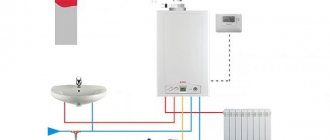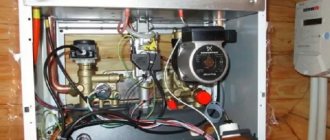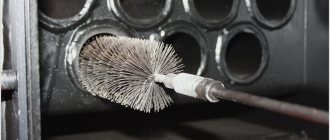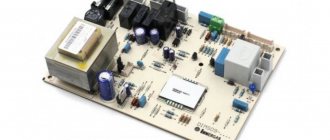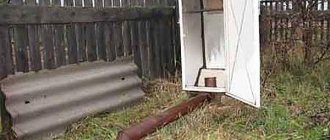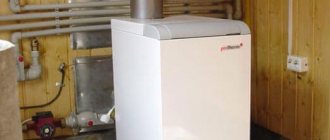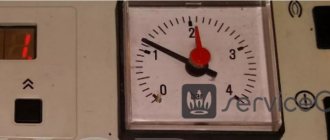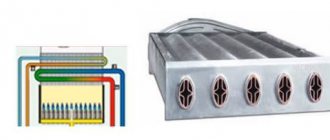Home / Gas boilers
Back
Published: 07/26/2019
Reading time: 4 min
0
2121
Many boiler owners have no idea what a parapet boiler is, although they have been using them for a long time. This modern unit belongs to the class of energy-efficient devices and removes flue gases using a coaxial chimney mounted in a through hole in the wall of the building.
The units are equipped with a closed firebox and can be installed in small rooms. Since the oxygen necessary for combustion is not taken from the living area, it is not dangerous. The heating unit is so compact that it can easily fit even in the kitchen under the windowsill.
- 1 What is a parapet boiler
- 2 Operating principle of parapet gas equipment
- 3 Types and prices
- 4 Installation of a parapet boiler
What are parapet gas boilers?
A parapet gas boiler is a compact boiler unit used for heating (single-circuit) and supplying objects with hot water (double-circuit).
In general, such models were initially developed as a non-volatile alternative to wall-mounted devices, but unlike the latter, they are universal when choosing a place for installation, i.e. they can be placed either wall-mounted or floor-mounted. The only condition is that it must be secured to the outer wall of the room, preferably below the line of the window sills.
Design and principle of operation of the equipment
In terms of functionality, parapet gas boilers are something between a classic atmospheric heat generator and an air convector.
This combination is achieved by modifying standard units:
- closed combustion chamber - completely isolated from the living space, which eliminates any influence of smoke products on the internal microclimate;
- primary heat exchanger - has dissipative turbulators that increase the passage time of air flows and prevent heat from evaporating;
- air intake and smoke removal system - implemented through a short (from 25 cm to 53 cm) coaxial pipe, without complex elbows, wiring and insulation;
- sealed steel housing - equipped with a viewing window for direct visibility of the burner flame, as well as convection holes, the so-called. ribs.
Schematic representation of the design and operating principle of parapet models.
The operating principle of parapet boilers is not entirely typical: despite the closed combustion chamber, they operate according to a natural air exchange (draft) scheme - street oxygen is supplied through the outer part of the pipe from below to the burner that heats the heat exchanger, after which the smoke is removed through the core of the pipe.
In the room itself, there is also a continuous circulation of air: passing through the ribs, it heats up and, increasing in volume, displaces the cold mass. Thus, if you choose the characteristics of the boiler correctly, it will be sufficient not only to heat the heating circuit, but also to heat the space around it (without a radiator).
Under what conditions is it most advisable to use such boilers?
Parapet models are used to organize heating and hot water supply (DHW) systems in buildings whose design does not involve the construction of a full-fledged chimney, as well as with problems in power supply and other aspects: stable pressure, soft water and high-quality fuel.
However, it is necessary to take into account the power limitation in the range from 4 to 46 kW, i.e., in terms of similar indicators, “parapets” are seriously inferior to both wall-mounted and, even more so, floor-standing units. This means that it is reasonable to install them only in relatively small rooms (from 30 to 250 m2), such as private and country houses, retail sites, offices in shopping centers and, of course, high-rise apartments, in which they fit perfectly into the niche under the windowsill in the kitchen.
How to choose a room thermostat and save up to 30% per month on heating
Possibility of installing a parapet boiler in a wooden house
Almost any wooden house can be equipped with a parapet boiler: the exception is barracks and other old-style apartment buildings.
Installation is carried out according to the current SNiP rules 42-101-2003:
- the unit is placed on an external wall, while an empty gap should remain outside - from 0.3 to 3.1 m (depending on the power), without facade elements;
- The chimney outlet must not be installed near or directly in enclosed spaces (entry, attics, entrances, balconies, loggias, etc.);
- the mounting wall is sheathed with fire-resistant material and covered with a sheet of steel so that there is a distance of 10–25 cm to difficult and easily flammable areas;
In wooden houses, internal and external thermal insulation of a coaxial chimney is mandatory - porous wood, in order to increase fire safety, is prepared in advance for overlapping, treated with special mastics and impregnations in 2-3 layers.
Many companies still use asbestos to protect walls from fire, although today it is officially recognized as a material hazardous to health. Ceramic or silicate bricks, GVP-slabs, mineral wool, basalt insulation, foam and aerated concrete panels, and even gypsum plaster can help replace it.
Principle of operation
The operation of a parapet boiler differs little from the usual operation of gas convection units.
The burner heats the coolant, which transfers part of the energy to prepare DHW or is discharged into the heating circuit after preparation in a three-way valve.
There are no changes in this. A specific feature is the ability of the boiler to perform the function of a convector, which makes it possible not to install radiators in the room where the unit is located.
In addition, a special method of air supply and smoke exhaust is used. When the burner is ignited, excess air pressure arises in the upper part of the combustion chamber, causing it to be expelled along with the smoke outside.
At the same time, a vacuum is formed in the lower part, creating a suction of fresh flow through the outer part of the coaxial pipe. A pressure difference arises similar to that used in conventional ovens.
This allows the use of a closed combustion chamber without a turbo fan.
IMPORTANT!
In some designs, the chimney and air intake pipe are made separately, but this does not change the principle of operation.
Reviews of domestic parapet boilers: advantages and disadvantages
Despite the fact that such units are still new to most people, there are users who have already tried them and formed their own opinion.
Common reviews from owners of parapet gas boilers:
| Advantages | Flaws |
| budget price - finding an option to suit every taste and budget is not difficult, since prices start from 10,000 rubles | manual control - ignition (piezo) and mode change (mechanical control) is possible only with human participation |
| freedom of communication - versatile connection of pipes reduces the cost of piping the unit and simplifies installation | meager automation - the set consists of a thermocouple that regulates the position of the gas valve and one thermostat |
| replacement of radiators - the holes in the casing themselves provide a good flow of heat, which means that the batteries in the room in which the boiler is installed can be removed | dependence on the weather - if a wind protection is not installed on the chimney, it often happens that the flame simply goes out due to the wind |
| energy independence - almost all models do not require power, but there are also universal ones that work “according to the situation” | inserting a chimney - to remove the pipe you will have to punch a hole in the wall, which is not allowed to be done in all houses |
In connection with the last drawback, one cannot help but note the likelihood of social difficulties also arising: there is no need to formally coordinate the installation with neighbors if technical parameters are observed, but they are unlikely to be happy with the release of carbon monoxide at the level of their windows, because this is also worth thinking about in advance .
Advantages and disadvantages
The main advantages of parapet boilers:
- high performance;
- closed combustion chamber ensuring complete safety;
- compactness;
- functionality;
- versatility;
- ease of use and maintenance.
The disadvantages include the need to drill a hole in the wall for the pipe, which negatively affects the supporting structures. If installing a gas boiler in a private house is not a problem, then equipping a city apartment with it is almost impossible, due to the current moratorium on such events. We should not forget about the high cost of equipment and installation work.
How to calculate the minimum required power
In most cases, to determine power (Q), a simplified formula is used, where 1 * kW of thermal energy is taken per 10 m2 of heated area.
- *approximate heat loss of a brick building with ceilings of 2.7 m from the central climatic zone of Russia.
For example, for a residential building of 120 m2 located in the Moscow region, the minimum required power of a parapet gas boiler will be Q=120÷10×1=12 kW.
We also recommend making a reserve of 15–20% of the power so as not to operate the heat generator at its limit for a long time, i.e. for the same object Q≈14–15 kW. Also, if we are talking about a double-circuit model, then you will have to add about 15–20% more to provide hot water supply, the total result will be Q≈16–17 kW.
In an apartment of 120 m2 (not corner), heat loss is a priori 10–15% less, so for a unit with one circuit Q≈12.5–13 kW, with two circuits Q≈14.5–15 kW.
How to accurately calculate the required boiler power Individual calculation, formula and correction factors
Main differences and characteristics
Parapet boilers can have 1 or 2 circuits - for heating and hot water.
Various models are made in floor and wall-mounted, left-hand and right-hand versions. Depending on the purpose, they are equipped with one circuit - only for heating or two - to additionally heat water for domestic purposes. Depending on the level of control, devices can be automatic or manual. For automation to work, electricity is required. If it disappears, the boiler turns off. Manually controlled products are practically independent of external conditions and can even be operated from a gas cylinder. The burner is turned on and off by a thermocouple and a constantly burning wick.
The best known manufacturers and models: characteristics and prices
Lemax Patriot-12.5
This unit can be briefly described in two words – simplicity and efficiency. Despite the fact that the heat exchanger is made of ordinary steel, thanks to its coating with anti-corrosion enamel and an inhibitory composition, it is less susceptible to aggressive substances: acids, salts and mineral oils and can last 12-15 years.
With a power of 12.5 kW, its fuel consumption will be no more than 0.75 m3, which is one of the best indicators. But the “picture” is spoiled by a rather clumsy rectangular-shaped case and an uninformative control system: of the devices for monitoring current parameters, only a thermometer is included “by default.”
Cost: 16,130 – 21,580 rubles.
Manufacturer: LEMAX (LEMAX), Russia.
Floor-standing gas boilers The most detailed selection instructions and the best models
ATON Compact-12.5EB
A relatively multifunctional boiler with a power of 12.5 kW is distinguished by its modest dimensions, which is not inherent in every double-circuit analogue: for flow-through heating it uses an S-shaped coil made of copper - a metal more resistant to corrosion and with increased thermal conductivity, serving up to 17 years .
The hot water supply rate t 35±5 °C can reach 5–6 l/min, while fuel consumption will not exceed 1.53 m3/h. The convenience of installation work will allow you to appreciate the model even more - versatile outputs allow you to connect it on both the right and left sides.
Cost: 23,350 – 27,500 rubles.
Manufacturer: ATON (ATON), Ukraine.
TERMOMAX S-12E
Another unit, devoid of any hints of design. Despite this circumstance, you should not write it off, because the lack of external attractiveness is compensated by economy, efficiency and real comfort of operation: the main control elements are located directly on the front of the outer panel.
On request, the boiler can be supplemented with an expansion tank and a circular pump (not included in the basic package), which will make it suitable for connection to complex heating systems, including those with high hydraulic resistance. Maximum gas consumption at a power of 12.0 kW is 1.39 m3/h.
Cost: 15,860 – 20,340 rubles.
Manufacturer: TERMOMAX (TERMOMAX), Ukraine.
Hephaestus VPR KSG-10S
Perhaps this option is one of the best parapet gas boilers for heating a private home: it is clear, almost silent (distinctively quiet at start-up) and quite highly efficient, given the ability to operate in the “small flame” mode, which allows reducing the average gas consumption to 0.60 m3/h.
Despite the fact that the unit itself has a Russian-made assembly, it contains the well-known Italian automation of the “SIT” type, which, based on the current heat losses, maintains an optimal power level (within 10 kW), as well as a slot burner of the “BRAY” type , which does not require air flow adjustment.
Cost: 19,680 – 23,840 rubles.
Manufacturer: Gefest WPR (Hephaestus VPR), Russia.
Installation of a parapet boiler
Parapet gas boilers are fire hazardous equipment, and therefore self-installation of the equipment is prohibited.
Installation and installation work of this type of equipment can be performed by certified craftsmen, and connected to the gas network by representatives of the city gas company.
Violation of these rules creates a danger to people's lives and can damage equipment.
Parapet boiler installation process:
- Exit the smoke exhaust system through the external wall of the room into the environment.
- Protect the top of the pipe with a windproof cap so that powerful winds do not tear the torch away from the nozzle.
- Install pipes for the water, gas network and hot water supply; it may be necessary to constantly maintain pressure, with installation in the pump circuit.
- The wall intended for installation of the unit is treated with fireproof materials for fire safety.
- The combustion room is equipped with a ventilation system.
- To comply with fire safety, it is prohibited to install the boiler closer than 0.5 m to furniture, wood or any other flammable objects.
- It is prohibited to remove the chimney in closed rooms, rooms made of SIP panels, entrances, and attics.
- Equipment is selected according to a previously completed thermal design design.
- The algorithm for the sequence of installation work depends on the device model. Specific instructions for intermediate stages of installation and commissioning are issued by the manufacturer.
- First, a channel is punched to release the chimney into the environment. The recommended place is near a window to facilitate future maintenance of the chimney for a gas boiler and checking its functionality.
- Install the air pipe and fix it so that the part does not move.
- The boiler feed line is being installed.
- Install studs in the wall to secure the boiler unit.
- The chimney section is installed in a similar way and secured with maximum density between the assembly elements. It is necessary to fix the chimney section at an angle to drain condensate.
- Adjust the gaps so that the flame burns evenly without interruption.
- They connect pipes, batteries and an expansion tank in the in-house heating system.
- After installation is completed, pressure testing of the water network is performed with a pressure of 1.5 times the operating pressure.
- A gas service representative is invited to connect the unit to the gas network.
Prices: summary table
Rating of the most popular models of parapet gas boilers:
| Model name | DHW, l/min | power, kWt | Efficiency, % | Flow, m3/h | price, rub. |
| LEMAX Patriot-12.5 | —— | 12,5 | 87 | 0,75 | 18 500 |
| ATON Compact-12.5EB | 5–6 | 12,5 | 90 | 1,53 | 25 000 |
| TERMO MAX C-12E | —— | 12,0 | 90 | 1,39 | 18 000 |
| Hephaestus VPR KSG-10S | —— | 10,0 | 92 | 0,60 | 21 500 |
TOP 5 single-circuit gas boilers
Single-circuit models are used either only for heating, or in conjunction with an external indirect heating boiler. This option allows you to obtain hot water without restrictions on water volumes and without temperature fluctuations. Let's consider several popular models:
Lemax Premium-10 10 kW
Single-circuit gas boiler of domestic production. Designed to heat 100 sq.m. The non-volatile design allows the unit to be operated without being connected to power supplies.
Main parameters of the boiler:
- installation type - floor;
- energy consumption - independent;
- Efficiency - 90%;
- gas consumption - 1.2 m3/hour;
- dimensions - 330x748x499 mm;
- weight - 41 kg.
Advantages:
- energy independence;
- well-organized service and spare parts supply;
- The design was created taking into account Russian climatic conditions.
Disadvantages:
- when heated to 50°, condensation appears in small quantities;
- there is no display, there is no way to obtain information about the state of the boiler components.
Non-volatile models are reliable and simple. They are quite safe, but require a high-quality chimney.
Lemax Premium-20 20 kW
Russian-made gas boiler. The power of the unit is 20 kW, which is suitable for rooms up to 200 sq.m. Equipped with fully mechanical control.
Boiler parameters:
- installation type - floor;
- energy consumption - non-volatile;
- Efficiency - 90%;
- gas consumption - 2.4 m3/hour;
- dimensions - 556x961x470 mm;
- weight - 78 kg.
Advantages:
- reliability, stability;
- Ease of Management;
- low cost.
Flaws:
- complex ignition;
- you have to adjust the gas pressure so that there is no popping noise when igniting.
Domestic non-volatile boilers are much simpler and cheaper than their European counterparts. This is both a plus and a minus of the units.
Protherm Wolf 16 KSO 16 kW
Slovak gas boiler with a capacity of 16 kW. Optimally suitable for heating a house with an area of 160 sq.m.
Main technical characteristics:
- installation type - floor;
- energy consumption - independent;
- Efficiency - 92.5%;
- gas consumption - 1.9 m3/hour;
- dimensions - 390x745x460 mm;
- weight - 46.5 kg.
Advantages:
- simplicity and reliability;
- no need to connect power supply;
- economical fuel consumption;
- stable operation in automatic mode.
Flaws:
- there is no indication of the state of the main components of the boiler;
- ignition using a piezoelectric element is somewhat difficult.
Gas boilers made by Slovak engineers are highly rated by users, which confirms the high demand.
BAXI ECO-4s 1.24F 24 kW
Gas boiler from a famous Italian manufacturer. The power of the unit is 24 kW, which corresponds to a service area of 240 sq.m.
Options:
- installation type: wall-mounted;
- power consumption - 220 V 50 Hz;
- Efficiency - 92.9%;
- gas consumption - 2.73 m3/hour;
- dimensions - 400x730x299 mm;
- weight - 29 kg.
Advantages:
- compactness, light weight;
- reliability, stability;
- full control over all systems and components using self-diagnosis;
- There is a display showing all the parameters of the unit, both current and permanent.
Flaws:
- when the power supply is turned off, the boiler operation stops;
- high price for the boiler itself and for spare parts.
Italian heating technology is considered elite. It successfully competes with German models in all respects, enjoys well-deserved recognition and high demand among buyers.
Lemax Leader-16 16 kW
Russian single-circuit non-volatile boiler. Its power is 16 kW, which allows you to heat rooms up to 160 sq.m.
Main characteristics:
- installation type - floor;
- energy consumption - independent;
- Efficiency - 90%;
- gas consumption - 1.9 m3/hour;
- dimensions - 431x856x515 mm;
- weight - 95 kg.
Advantages:
- stable, sustainable work;
- low cost of the boiler and repair work;
- independence from power supply.
Flaws:
- minor flaws made during assembly;
- heavy weight.
Floor-standing gas boilers are not limited in the weight and size of units, which allows you to create more powerful and durable units.
Why does the boiler blow out in the wind and what to do in this case?
Blowing out may indicate a failure in the connection of the chimney and automation; more often it indicates a lack of wind protection on the head. However, in general, blowing out the burner flame by the wind is a significant and most well-known problem with parapets, which is why they never gained super popularity.
As a rule, the casing of a coaxial chimney, manufactured in a factory, already has a special insert that protects against gusts of wind. If it is not included in the kit, then you will have to look for a suitable deflector or make it yourself: give a sheet of galvanized steel the desired shape, and then attach it to the head with press washers or rivets.
Factory wind protection and an example of a homemade solution by the owners.
When the boiler still goes out after installing the protection, there is no point in doing anything further: you can, of course, continue to install new heads and deflectors, add bends to the coaxial pipe, or install a vertical chimney, but then the whole point of installing a parapet model will be lost.
DIY boiler installation
A protective cap is installed on the chimney to prevent the wind from blowing smoke back in.
Installation of the boiler must be carried out by gas industry specialists. The property owner can prepare a base or a place on the wall for it, drill a hole for the chimney and make connections for heating and hot water supply. Fixing the device and connecting communications is carried out by a specialist. Exceptions are cases when the boiler is connected to a gas cylinder.
To prevent the wind from blowing into the boiler, it is necessary to make a protective cap at the end of the chimney at the installation stage, which will dampen turbulence and strong air currents. Periodically, the inner pipe must be cleaned of soot, since internal deposits reduce draft.
Where to buy a parapet gas boiler for heating a private house or apartment
In Moscow and Moscow Region
- MirCli (mircli.ru/search?keyword=parapet+gas+boiler+heating) – Leningradsky Ave. 80, building G, tel. +7 (863) 303–35–06, +7 (800) 775–29–90.
- ProComfort (pro-komfort.com/kotly-otopleniia/parapetnye-gazovye) – 1st Vyazovsky Prospect, 4, building 19, tel. +7 (800) 333–56–02, +7 (863) 333–26–06.
In St. Petersburg
- ThermoMIR (thermomir.ru/parapetnye_gazovye_kotly_rossijskogo_proizvodstva) – st. Lensoveta building 62, building 1, tel. +7 (812) 615–80–19, +7 (800) 500–47–02.
- TeploDvor (ru/kotly-otoplenija/napolnye-gazovye-kotly/parapetnye) – Vitebsky Ave. 3/B, office 25, tel. +7 (812) 628–13–33, +7 (800) 775–21–95.
And in conclusion, I would like to clarify that such boilers are not yet a full replacement for either wall-mounted or floor-standing units. In fact, in the desire to “embrace the immensity,” manufacturers take half measures, cutting back on certain parameters. Personally, we recommend taking a familiar, but more reliable and effective analogue.
Gas boilersParapet boilers
Where you can and where you can’t install a gas boiler
The rules for installing a gas boiler provide the following requirements for installing a HEATING boiler, regardless of whether it also provides DHW or not:
- The boiler must be installed in a separate room - a furnace (boiler room) with an area of at least 4 square meters. m., with a ceiling height of at least 2.5 m. The rules also state that the volume of the room must be at least 8 cubic meters. Based on this, you can find indications that a ceiling of 2 m is acceptable. This is incorrect. 8 cubic meters is the minimum free volume.
- The furnace room must have an opening window, and the width of the door (not the doorway) must be at least 0.8 m.
- Finishing the furnace with flammable materials and the presence of a false ceiling or false floor are unacceptable.
- The combustion chamber must be provided with an air flow through a through, non-closed vent with a cross-section of at least 8 sq.cm. per 1 kW of boiler power.
For any boilers, including wall-mounted hot water boilers, the following general standards must also be met:
- The boiler exhaust must exit into a separate flue (often incorrectly called a chimney); using ventilation ducts for this is unacceptable - life-threatening combustion products can reach neighbors or other rooms.
- The length of the horizontal part of the flue should not exceed 3 m within the combustion chamber and have no more than 3 rotation angles.
- The flue outlet must be vertical and raised above the ridge of the roof or the highest point of the gable on a flat roof by at least 1 m.
- Since combustion products form chemically aggressive substances when cooling, the chimney must be made of heat- and chemically resistant solid materials. Use of layered materials, e.g. asbestos-cement pipes, permissible at a distance of at least 5 m from the edge of the boiler exhaust pipe.
When installing a wall-mounted hot water gas boiler in the kitchen, additional conditions must be met:
- The height of the boiler suspension along the edge of the lowest pipe is not lower than the top of the sink spout, but not less than 800 mm from the floor.
- The space under the boiler must be free.
- A durable fireproof metal sheet 1x1 m should be laid on the floor under the boiler. Gas workers and firefighters do not recognize the strength of asbestos cement - it wears out, and the SES prohibits having anything containing asbestos in the house.
- There should be no cavities in the room in which combustion products or an explosive gas mixture can accumulate.
If the boiler is used for heating, then the gas workers (who, by the way, are not very friendly with the heating network - it always owes them for gas) will also check the condition of the heating system in the apartment/house:
- The slope of horizontal sections of pipes must be positive, but not more than 5 mm per linear meter of water flow.
- An expansion tank and an air valve must be installed at the highest point of the system. It is useless to convince you that you will buy a “cool” boiler that has everything provided for: rules are rules.
- The condition of the heating system must allow it to be pressurized under a pressure of 1.8 atm.
The requirements, as we see, are strict, but justified - gas is gas. Therefore, it is better not to think about a gas boiler, even a water heating one, if:
- You live in a Khrushchev block or other apartment building without a main gas duct.
- If you have a false ceiling in your kitchen that you don’t want to remove, or a permanent mezzanine. On a mezzanine with a bottom made of wood or fiberboard, which in principle can be removed, and then there will be no mezzanine, gas workers turn a blind eye.
- If your apartment is not privatized, you can only rely on a hot water boiler: allocating a room for a furnace means redevelopment, which only the owner can do.
In all other cases, it is possible to install a hot water boiler in an apartment; wall heating is possible, but floor heating is very problematic.
In a private house, you can install any boiler: the rules do not require that the furnace be located directly in the house. If you make an extension to the house from the outside to serve as a furnace room, then the authorities will only have less reason to find fault. You can install a high-power floor-standing gas boiler in it to heat not only the mansion, but also the office premises.
For middle-class private housing, the optimal solution is a wall-mounted boiler; it does not require, as for a floor one, to install a brick or concrete tray with sides of half a meter. Installing a wall-mounted gas boiler in a private house also avoids technical and organizational difficulties: a fireproof closet under the furnace can always be fenced off, at least in the attic.
What does a boiler consist of and how does it work?
Parapet gas boilers for heating a small private house perfectly heat the home. The inability to connect to a standard type of chimney does not affect the performance of the equipment. Before installation, it is worth studying the design of the device, the principle of its operation, so that the system works without failures after assembly.
Components
Fuel is burned in the combustion chamber to heat the liquid circulating through the pipes and radiators in a heat exchanger.
Fuel is supplied through a gas burner equipped with a valve.
The body is made of steel, from which there is a pipe for the intake of fresh air with the simultaneous removal of combustion products.
Operating principle
The heating apparatus begins its operation by activating the pilot burner through piezo ignition, which begins the active supply of gas to the burner.
Gas burning
Inside the boiler, hot gases are directed to the heat exchanger, heating the coolant.
When operating single-circuit boilers, hot air exits through convection openings on the body itself, which are covered with decorative grilles.
The liquid inside the pipeline heats up to no more than +90 ºС, at the maximum value the sensor is triggered and the gas valve shuts off the gas supply. When the system cools down, the valve opens, gas is supplied, and the burner starts working again.
When the fuel supply stops, the pilot burner goes out. The system begins to operate only with the help of piezo ignition.
Equipment traction options
During operation of the unit, fuel burns and flue gases are generated. To remove them from a living space, natural or forced draft is necessary. It will ensure timely removal of all combustion products and released harmful substances from the apartment or house.
Natural draft modules
Boilers operating on natural draft have a simple design and take the air necessary for proper combustion from the room in which they are located. During intensive use, a certain amount of steam and various chemicals are released. Emissions are removed through a vertical chimney.
Among the main advantages of units with natural draft are reasonable cost, energy independence and absence of noise effects during operation.
In general, devices with natural draft are convenient and good, however, when the pressure in the gas pipeline drops, the quality of their work decreases significantly. At the same time, the risk of rapid burnout of the burner increases, since the fire at a reduced pressure level dies out or goes inside the burner device.
Uneven pressure in the main networks provokes serious overconsumption of fuel, which entails an increase in the amount of utility bills.
Forced draft devices
Boilers with forced draft are sometimes called forced-air or fan-type. They take air not from the room where they are located, but from the street. The modules have closed combustion chambers, and waste substances are emitted through a coaxial horizontal outlet using a powerful fan built into the system.
A coaxial bend consists of two pipe elements of different diameters inserted into one another. Through the smaller pipe, combustion products exit the room, and through the space between the small and large pipes, fresh air enters the room from the street, which is necessary for the full functioning of the boiler
Products with forced draft are easy to install, do not make any demands on the location, do not “eat up” oxygen in residential premises, work stably and accurately even with reduced gas pressure in the central main networks and do not require the installation of an additional vertical chimney.
The devices are criticized for the noisy operation of fan elements, higher cost and dependence on power supply.
